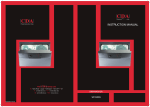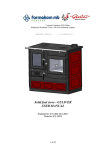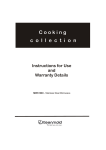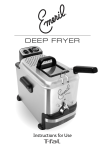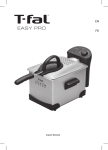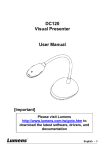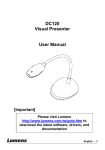Download DW34W DW34X
Transcript
DISHWASHER c o l l e c t i o n ▼ Instructions for Use and Warranty Details Dishwashers DW34 W - White DW34 X - Stainless Steel 2 CONTENTS 1/ FOR THE USER’S ATTENTION • Safety instructions ______________________________________ • Protection of the environment______________________________ • Economical, environmentally friendly washing ________________ 2/ DESCRIPTION OF YOUR APPLIANCE • General presentation of the dishwasher ____________________ • Presentation of the control panel __________________________ 3/ INFORMATION ______________________________________________ 4/ WHAT TO DO BEFORE FIRST USING THE MACHINE • Measure the water hardness and select the type of detergent __ • Hardness table__________________________________________ 5/ DETERGENT PRODUCTS AND ADJUSTING THE WATER SOFTENER • For traditional products __________________________________ • For multi-purpose products:________________________________ 6/ LOADING OF REGENERATING SALT __________________________ 7/ LOADING OF RINSING PRODUCT ____________________________ 8/ YOUR DISHWASHER’S EQUIPMENT • The lower basket ________________________________________ • The upper basket ______________________________________ • The cutlery basket ______________________________________ 9/ YOUR DISHWASHER’S SAFETY SYSTEMS ____________________ 10/ WASHING PROGRAMMES TABLE ____________________________ 11/ PROGRAMMING __________________________________________ • AUTOCLEAN option ____________________________________ 12/ CLEANING YOUR APPLIANCE • Cleaning the waste filters ________________________________ 13/ IF OPERATING ABNORMALITIES OCCUR ______________________ 14/ INDICATIONS FOR THE TESTING LABORATORIES 15/ WARRANTY AND SERVICE 3 4 5 5 6 7 8 9 9 10 10 12 13 14 15 16 17 18 20 21 22 24 1/ FOR THE USER’S ATTENTION • Children’s safety Important : — This appliance is not intended for use by young children or infirm persons unless they have been adequately supervised by a responsible person to ensure that they can use the appliance safely. — This appliance must only be used by adults. Ensure that children do not touch it and do not use it as a toy. Ensure that they do not operate the appliance’s controls. — Keep young children away from the appliance when it is operating. — Detergents contain irritant and abrasive substances. These products can have caustic effects on the eyes, the mouth or the throat. They can be extremely dangerous if ingested. Avoid any contact with the skin and the eyes. Ensure that the appliance’s detergent container is empty at the end of the washing cycle. — Place detergents out of children’s reach and do not put any detergent in the machine until just before you start the washing programme. — The water in your dishwasher is not drinking water; this is why children must not go near the appliance when its door is open. — Do not let your children play or sit on the door when it is open. — Once you have unpacked your appliance, place the packaging out of children’s reach. — Keep all the packaging materials (e.g. plastic bags, polystyrene, etc.) out of children’s reach because they can be dangerous for children (ie. risk of suffocation). Keep this user’s manual with your appliance. If the appliance is sold or transferred to someone else, ensure that the manual is with it. Please take note of these instructions before installing and using your appliance. They have been drawn up for your own and other people’s safety. • SAFETY INSTRUCTIONS • Installation — When you receive your appliance, unpack it or have it unpacked immediately. Check that it has not suffered any damage during transport. Express any reservations in writing on the delivery note, of which you keep a copy. Never connect up a damaged machine. If your appliance is damaged, please contact your dealer. — Before proceeding to connect up your machine, please refer to the instructions in your Installation Guide. — Your dishwasher must be kept disconnected from the mains supply throughout the whole of the installation process. — The electrical connection details on your appliance’s description plate must comply with those for the mains supply. — The socket must still be accessible once your appliance has been installed. — Do not alter or attempt to alter the appliance’s characteristics. This could put you at risk. — If your installation has to be altered, only entrust the electrical and plumbing work to a qualified electrician or plumber respectively. — Your appliance is designed for normal domestic use. Do not use it for industrial or commercial purposes or for any other purpose than that for which it has been designed. — The dishwasher’s walls must not be pierced under any circumstances. • Use — When machine is running, do not open door. This may provoke steam leakage or splattering of water. — Only use products specially designed for your dishwasher (water softening salt, detergent and rinsing products). — As far as possible, avoid opening the dishwasher’s door when it is operating, and in particular during the heating phases, because scalding steam may escape or you may be splashed with hot water. The machine is fitted 4 1/ FOR THE USER’S ATTENTION with a safety system that immediately blocks the dishwasher’s operation if the door is opened. — Never use chemical solvents in your appliance because these could cause an explosion. — Always close your appliance’s door after loading or removing your items. — Do not lean or sit on your appliance’s door when it is open. — You are strongly advised to disconnect the machine after use and turn off the water supply. — Unplug your machine before carrying out any technical work on it. — Avoid placing your machine immediately next to a cooking or heating appliance to prevent any risk of heat damage; — Do not place any items in your machine, which are not certified as dishwasher safe. — If you have removed an item before the end of the washing programme, it is important to rinse it carefully to remove any residual washing products. — If your appliance breaks down, never attempt to repair it yourself. Any repairs made by non-qualified personnel can cause significant damage or lack of control. — The machine complies with applicable safety regulations. Any repairs should be carried out by qualified technicians. Repairs or changes that do not conform may be dangerous for the users. In case of replacement, only use original parts. — If the machine malfunctions due to other causes than those mentioned in this booklet, disconnect the machine (remove the plug) or break the circuit concerned and contact Kleenmaid’s after-sales service. • ENVIRONMENTAL PROTECTION This appliance’s packaging material is recyclable. Help recycle it and protect the environment by dropping it off in the municipal receptacles provided for this purpose. Broken machines should be taken to the closest recycling centre. Destroy the door closing system so it no longer works (children may close themselves in whilst playing and suffocate). Cut the electric cable after having removed the plug from the socket. Your appliance also contains a great amount of recyclable material. It is marked with this label to indicate the used appliances that should not be mixed with other waste. This way, the appliance recycling organised by your manufacturer will be done under the best possible conditions, in compliance with European Directive 2002/96/EC on Waste Electrical and Electronic Equipment. Contact your council for the used appliance collection points closest to your home. We thank you doing your part to protect the environment. • ECONOMICAL, ENVIRONMENTALLY FRIENDLY WASHING — Remove any food residue from your crockery (bones, pips, etc.) — Do not pre-wash your items by hand (useless waste of water). — Utilise your dishwasher’s capabilities to the full for an economical, environmentally friendly wash. — Always select a washing programme suitable for the crockery type and how dirty they are. — Avoid overdosing with detergent, regenerating salt and rinsing liquid. Follow the recommendations in this guide (pages 9 - 13) and the instructions on the product packs. — Ensure that the water softener is correctly set (see pages 10 - 11). 5 2/ DESCRIPTION OF YOUR APPLIANCE • GENERAL PRESENTATION OF THE DISHWASHER A B C D E F G H I J Fig. 01 A Removable top F Regenerating salt tank B Upper basket G Waste filter C Washing products dispenser H Main filter D Oversize plate barrier I Rinsing product dispenser E Lower sprinkler arm J Description plate (After-Sales reference) Advice: This user’s guide is applicable to several models. There may be some slight differences in the details and the equipment between your appliance and the descriptions provided here. 6 2/ DESCRIPTION OF YOUR APPLIANCE • PRESENTATION OF THE CONTROL PANEL G On / Off Salt AUTOCLEAN Rinse Intensive Opti 60 AUTO Universal Start / Cancel Normal Quick Delayed Start Normal Eco Prewash Fig. 02 A A D F E AUTOCLEAN: A specific maintenance programme specially designed for your dishwasher. (Please refer to Chapter “10/The washing programmes” and Chapter “12/Cleaning your appliance). Programme selector: Turn the selector to choose your programme. G C C F ON/OFF: Press this button to start your machine. B B Indicator lights: • Salt: Start/Cancel: Press this button to Lit: Indicates lack of regenerating salt. confirm your programme. Hold it down for three seconds to cancel the programme. • Rinse: Lit: Indicates lack of rinsing product. D Selecting washing with delayed start. - Is also the water softener setting button. • Programme error or incident. • Keypad locked. • Washing product Lit: Indicates that your dishwasher is set for using “2, 3, or 4-in-1” tablets. E Display for information and viewing the remaining time for the programme. 7 3/ INFORMATION Important: Important: To obtain impeccable washing and drying results from your dishwasher without any marks, you must set it carefully using the water softening system, which utilises regenerating salt. Never use normal washing-up liquid. For ease of use and in certain water hardness conditions only (<35°F), multi-purpose products can make the use of regenerating salt and rinsing liquid unnecessary. • “Two-in-one” tablets contain detergents and rinsing liquid or an agent serving the function of the salt. • “Three-in-one” tablets contain detergents and rinsing liquid as well as an agent serving the function of the salt. • “Four-in-one” tablets also contain additives that prevent wear on poor quality glasses or the risk of stainless items corroding. As rainwater infiltrates into the ground it picks up mineral salts; some minerals are found in solid form and are commonly called ‘lime’. This reduces the detergent’s washing performance and leaves white marks on the crockery. The more lime there is in the water, the ‘harder’ the water is. - Use the most suitable washing products for the hardness of your town’s water supply. - There are several types of products: Important: Follow the instructions in the user’s manual and the recommendations on the multi-purpose detergent’s pack. NB: If in any doubt, please contact the detergent’s manufacturer if the items are very wet at the end of the programme or if chalky deposits appear. For an impeccable clean, opt for using traditional products together: ① Washing product for a perfect clean (standard powder, liquid or tablets). ② Regenerating salt for your dishwasher’s water softener to work correctly. ③ Rinsing liquid to assist drying and eli- minate drip marks. 8 4/ BEFORE FIRST USING THE MACHINE • MEASURE THE WATER HARDNESS AND SELECT THE TYPE OF DETERGENT: TRADITIONAL OR MULTI-PURPOSE In one simple action, you can test the your water’s lime content using the testing strip supplied with your dishwasher. Alternatively, contact your local water utility to ascertain your water’s hardness. — Let the water run from the tap for a few moments. — Fill a glass with water. — Take the test strip from its holder and immerse it for 3 seconds. — Wait 1 minute, shake it and look at the colours to ascertain your water’s hardness. • HARDNESS TABLE Test strip Hardness Water 0-10°F Soft Water softening and use of salt Optional 10-25°F 25-40°F Slightly hard Slightly hard Essential if using Essential if using traditional traditional products products Possible use of traditional products ➊ ➊ or ➋ or + + 40-55°F Hard 55-70°F Hard > 70°F Very hard Mandatory Mandatory Mandatory Use only of traditional products ➊ R or Multi-purpose + + R ➋ ➊ Traditional products: P : Powder detergent or L : Liquid detergent + S : Regenerating Salt + R : Rinsing product Multi-purpose tablets ➋ Multi-purpose products: 9 5/ DETERGENT PRODUCTS AND ADJUSTING THE WATER SOFTENER • FOR TRADITIONAL PRODUCTS • Your machine must be specially adjusted to use traditional products. • Proceed as follows to adjust the water softener on the control panel: Delayed Start” button; a long press on the button provides access to the — This is set using the “D menus. The screen shows Set to indicate that you are in Setting mode. — Press “Delayed Start” successively to alter this setting (to suit the hardness of the water). Each press adjusts the setting. — The setting is validated automatically after 5 seconds if the “Delayed Start” button is not pressed again. — Refer to the table below. • FOR MULTI-PURPOSE PRODUCTS • Your machine can be specially adjusted to use multi-purpose products if the water hardness is < 25°F. Delayed Start” button; a long press on the button provides access to the — This is set using the “D menus. The screen shows Set to indicate that you are in Setting mode. — Press “Delayed Start” successively to alter this setting (to suit the hardness of the water). Each press adjusts the setting. — To use multi-purpose tablets, you must alter this setting. To do this, use brief presses on the “Delayed Start” button to select c0 or c1, depending on the water’s hardness. NB: For better coverage of the variety of multi-purpose products available, your dishwasher’s “4-in-1” option has two possible settings 1) “Extra Dry” (factory setting) improves drying results in the event of lower performance from the type “2-in-1”, “3-in-1” or “4-in-1” multi-purpose product. 2) “Sparkling Clean” prioritises the brilliance of your items, whatever the type of multi-purpose product used. • Proceed to set the “ ” option, if necessary — Press the “Delayed Start” button to select “Sparkling Clean”. — Press the button again if you wish to return to “Extra Dry”. — The setting is validated automatically after 5 seconds if the “Delayed Start” button in not pressed again. Softener setting — Refer to the table below. Test strip hardness Traditional products Multi-purpose products c0 0 - 10°F “Extra Dry” c0 (factory setting) c0 “Sparkling Clean” cI “Extra Dry” cI “Sparkling Clean” cI 10 - 25°F 25 - 40°F 40 - 55°F 55 - 70°F > 70°F Factory setting: c 3. c2 c3 c4 c5 : Light permanently lit 10 : Light flashing 5/ DETERGENT PRODUCTS AND ADJUSTING THE WATER SOFTENER Important: It is very important to set the water softener correctly. - If the setting is too low, there is the risk of chalky marks appearing. - if the setting is too high, there is the risk of causing clouding of the glasses. If you relocate, adjust the water softener setting as required. • Traditional tablets Non-multipurpose tablets should be placed in the external compartment (Fig 11) or, for optimum performance, pull out the dispenser drawer and lay the tablet inside (Fig 12). • Powders or liquids (Fig 10) Fill at least up to the minimum mark for slightly dirty crockery and to the maximum mark for dirty crockery. If the crockery is very dirty and for programmes with a pre-wash we recommend that you add 5g of detergent (a dessert spoonful) into your dishwasher’s tub in accordance with the programmes table. Important: Keep these products out of children’s reach and away from dampness. Only use products specially designed for dishwashers. Fig. 10 Fig. 11 Fig. 12 Important: The setting for multi-purpose products enables you to deactivate the rinsing product and salt warning lights only on c0 and “4-in-1”. • Loading the multi-purpose tablet dispenser To assist in loading the detergent, the distributor is situated on the front of the upper basket. It is compatible with all the products recommended for dishwashers. • Place the tablet in the external compartment (Fig 11 on previous page) or, for optimum results, pull out the distributor’s drawer and lay the tablet inside (Fig 12 on previous page). - Close the dispenser. 11 6/ LOADING OF REGENERATING SALT • Loading of regenerating salt (Fig 13) Filling with salt is essential for providing a good wash without marks. It regenerates the resins that soften the water, by removing its lime content (unless the mains water supply is soft enough). Refer to “Setting the water softener”. A Important : SE Salt L Only use special dishwasher regenerating salt. Do not use table salt or any type of cooking salt, this could damage your appliance’s water softener. A Unscrew and remove the stopper on the salt tank. B Fill the tank with regenerating salt specially designed for dishwashers. C Use the funnel supplied with your dishwasher. The first time, top up with water up to the rim of the tank. Uater EAw B • Regenerating salt indicator: This illuminates when salt must be added. After the tank has been filled with regenerating salt, the indicator light may remain lit until the salt has dissolved sufficiently, usually after one cycle (of if the tank has not been filled completely; for example, when first putting the machine into service using the sample). C Fig. 13 Important If the salt overflows when filling the tank, to avoid oxidization of the tub it is advisable to remove the salt crystals or to run a Prewash programme. 12 7/ LOADING OF RINSING PRODUCT • Loading of rinsing product (Fig. 14) Important : Only use a rinsing product designed for dishwashers. The rinsing product ensures your items shine and are well dried. A A B When first putting the machine into service, fill the tank until the level is flush with the top of the adjustment lever. Pour in at least all the rinsing product provided. The tank contains 120 ml (approximately one glass) The original setting is in the centre (middle position: reference mark 2). If you encounter marks or poor drying after a few cycles, you can adjust the setting using the adjustment lever (fig 14 C ; Reference mark 3 will increase the setting). - Close the tank lightly 3 12 B • Rinsing liquid indicator light: This illuminates when rinsing product is required. 12 3 Important : If any of the product overflows during filling, sponge up the excess to avoid producing foam. C Fig. 14 13 Adjustment lever 8/ YOUR DISHWASHER’S EQUIPMENT Very important Items not suitable for washing in a dishwasher: - Wooden cutting boards - Stainless steel utensils or plastic utensils that are not heat-resistant - Copper or pewter items - Glued crockery and cutlery - Cutlery with wooden, horn or mother-of-pearl handles - Antique or hand-painted porcelain When purchasing crockery, glasses or cutlery, ensure that it is dishwasher-safe • THE LOWER BASKET Arrange your items so that the water can circulate freely and spray over all the utensils. Place large diameter dishes and pans at the sides. Do not intersperse, jam together or superimpose flat plates and concave dishes (Fig. 15). The flexible racking spikes makes it easier to arrange your large dishes (Fig. 16). Advice: When you re-insert the lower basket, ensure that nothing catches on the oversize plate barrier to avoid blocking the rotating spray arm. Fig. 15 Unloading your items Empty the lower basket to avoid drips from the upper basket falling onto the lower basket. Fig. 16 14 8/ YOUR DISHWASHER’S EQUIPMENT • THE UPPER BASKET This basket is particularly designed to take glasses, cups, ramekins, small salad bowls, bowls and saucers. Arrange your items methodically to save on space (arranging glasses, cups or bowls together). You can also arrange cups, ladles, etc. on the folding cup racks (Fig. 17) Advice: Position the cavities of glasses, cups or bowls facing downwards. Cutlery basket Fig. 17 • Adjusting the height of the upper basket For large dishes to be loaded in the lower basket, the upper basket must be set the to high position. This can be done with the basket fully loaded (Fig. 18) ① Setting in HIGH POSITION: Gently raise your basket on each side until it engages. Fig. 18 ② Setting in LOW POSITION: Raise your basket completely on both sides to unlock it and then lower it to the low position. Important : Check that the two slides are set to the same height and the basket is horizontal. 15 8/ YOUR DISHWASHER’S EQUIPMENT • THE CUTLERY BASKET The cutlery basket slides to allow flexible loading. It can be placed anywhere in the lower basket. You can therefore make a variety of loads depending on the items (Fig. 19). If your cutlery items or your dishes are too large, alter the height setting for the upper basket. Fig. 19 Movable grills are available for if you wish to load your cutlery in an orderly manner (Fig. 20). For optimum washing and drying, use these separation grills partially or totally. Point the handles on the cutlery downwards. Important : Fig. 20 For safety reasons, we recommend that you place knives with pointed ends with the point facing downwards in the cutlery basket (to avoid the risk of an accident). Long-bladed knives and other sharp kitchen utensils must be placed flat in the upper basket. Avoid washing cutlery with horn handles in your dishwasher. Separate silverware from other metals using the separation grill. 16 9/ YOUR DISHWASHER’S SAFETY SYSTEMS • SAFETY SYSTEMS • Door not closed properly The light flashes when the door is open or not closed properly. • Programme access lock While your programme is running, the programme selector is automatically protected from manipulation. It unlocks automatically at the end of the programme or if the programme is cancelled. The light is permanently lit. • Anti-overflow system This system automatically activates the drain pump if the water level in the tub reaches an abnormal height. • Anti-leak protection system This system interrupts the water supply if a leak is detected under the appliance. • Warning light Programme error or incident (please refer to Chapter “If operating abnormality occur”). Remark: To unlock, hold down the Start/Cancel button for three seconds. 17 10/ WASHING PROGRAMMES • PROGRAMMES TABLE ITEM TYPE (porcelain, pans, cutlery, glasses) FOOD RESIDUE: Quantity, type and amount PROGRAMMES PROGRAMME SEQUENCE Resistant Very dirty A large amount of dried-on residue, baked-on stains, grease, residue from frying, cooked cheese, sauce, etc. Intensive Hot pre-wash Mixed Mixed Normally dirty Short 60-minute A normal amount wash specially of dried-on designed for daily and greasy washing with a residue on limited amount of everyday items. slightly sticky Faster, but residue. consumes more energy. Universal Opti 60 Pre-wash Mixed Automatically detects the amount of washing up and the level of soiling. Normal amount of dried on residue on everyday items. Faster, but consumes more energy. AUTO Pre-wash Washing at 70°C Washing at 65°C Washing at 60°C Washing at 55/65°C Rinse Rinse Rinse Rinse Hot rinse Hot rinse Hot rinse Hot rinse Drying by condenser Drying by condenser Drying by condenser Drying by condenser As an indication only: Duration in min Water (L) Energy (Kwh) These values refer to normal conditions of use with separate products (detergent, salt, rinsing product). They may vary according to the load, the temperature, if you use combined washing products, the water hardness and the supply voltage. 18 Normal 10/ WASHING PROGRAMMES AUTO Mixed Mixed Mixed Mixed Empty Normally dirty A normal amount of dried-on, adhering residue on everyday items. Normally dirty Recommanded for normally soiled load, less consuming in energy. Very short 30minute wash specially designed for a small amount of daily items with a limited amount of non-greasy residue, not dried on. Very short cycle (with no detergent) for rinsing and re-dampening the items while waiting for a wash expected in the following two days. Specific maintenance programme accessible by pressing the AUTOCLEAN button. Empty your machine completely and remove the largest amount of residue from your filter. Normal Normal Eco Quick Pre-wash Pre-wash Washing at 55°C Washing at 45°C Washing at 45°C Rinse Rinse Rinse Hot rinse Hot rinse Hot rinse at 60°C Drying by condenser Natural drying Natural drying Prewash Cold pre-wash 120 min 13.4 L 0.78 Kwh 19 AUTOCLEAN Degreases and de-scales your dishwasher’s tub, thereby maintaining its efficiency and prolonging its service life. For optimum results, use a cleaner specially designed for your dishwasher or use a powder or a pellet in the dispenser drawer. 11/ PROGRAMMING G On / Off Salt AUTOCLEAN Rinse Intensive Opti 60 AUTO Universal Start / Cancel Normal Quick Delayed Start Normal Eco Prewash Fig. 02 A D F E B C Advice: Consult the Programmes table on the preceding pages to determine the programme you need for the type of items, the quantity and the amount of food residue. • Immediate programme start Turn the programme selector B to select your programme. Press “Start” C , The programme starts. The “locked” indicator light illuminates. The “Remaining Time” light E illuminates and the display tells you the time remaining for the programme. The time counts down as the programme progresses. Remaining programme time Programme end • Delaying the start of a programme Press the button successively to select a start delay, for up to 12 hours delay. Confirm by pressing “Start”. Delayed Start The “Locked” light illuminates. The display counts down hour by hour until the programme starts. 88 Waiting for delayed start Waiting for delayed start Remaining time for programme Programme end Remarks: The door’s electrical safety system can cause the indicator lights to illuminate briefly when the door is opened or closed. This does not affect your machine’s operation. If required, and particularly after the water softener has been reset, the programme may start with three minutes of resin regeneration. This is a silent operation. 20 11/ PROGRAMMING • THE AUTOCLEAN OPTION • The Autoclean programme AUTOCLEAN Is a specific maintenance programme for your dishwasher when empty of crockery. - Press the AUTOCLEAN button. F - The display shows you the remaining time for the programme. - Confirm by pressing “Start / Cancel” C . The programme starts. - The “Locked” light Advice: Use this programme periodically, every three months, to remove any deposits. Use a special dishwasher cleaning product. • Cancelling a programme Hold down the “Start / Cancel” C button for a few seconds. 21 Start / Cancel 12 / CLEANING YOUR APPLIANCE • CLEANING THE WASTE FILTERS ➀ The filtration system consists of several elements: A - The waste filter B - The large main filter B A C - The micro filter ➁ The filters are located in the centre of the tub and must be washed regularly to obtain optimum washing results. Actions : ➀ Before removing the filters, remove any waste on the large main filter B with a sponge so that the waste does not block the sprinkler arms. Rotate the spray arm as shown in the drawing. (Fig. 21) A ③ ➁ Loosen the waste filter a quarter of a turn and then remove it A ③ Remove the main filter B ④ Remove the micro filter C B C ④ C ⑤ Carefully clean filters A , B and C under running water (Fig. 22) Fig. 21 ⑤ Re-installation: Proceed in reverse order, inserting filters C and B and then A A Important : Fig. 22 Remember to lock the waste filter A in place by pushing it in fully and turning it a quarter turn. 22 B C 12 / CLEANING YOUR APPLIANCE • Periodically Every 3 or 4 months, in order to remove any deposits, run a special ‘AUTOCLEAN’ maintenance programme, without any items in the machine, using a special dishwasher cleaning product. Important : Keep this product out of children’s reach. • AUTOCLEAN: A maintenance programme specifically for you dishwasher when empty. - Press the AUTOCLEAN button. - The screen shows you the time the programme will end. - Confirm by pressing “Start””. The programme starts. • If not using your dishwasher for a prolonged period: Clean your dishwasher completely and then unplug it from the electricity supply and close the water tap. Protect your machine from potential frost. Advice : Do not use abrasive powders, metal sponges and alcohol-based or thinner-based products. Use a cloth or a sponge. If you are moving house, run a soaking programme first of all, in order to avoid any water escaping. 23 13/ IF OPERATING ABNORMALITIES OCCUR • SUMMARY OF THE FAULTS d01: water supply fault (tap) d07: overflow / anti-leak fault d02: draining fault d08: sprinkling distribution fault d03: heating fault d11: pressure sensor fault d04: temperature fault d12: filling fault (water inlet detection system) d05: fault – motor under load d13: overheating fault d06: fault - motor overload d14: pump filling fault • BEFORE CALLING FOR SERVICE Problem Possible Causes What to do? The door falls heavily when - Door springs not tensioned - Tighten the two tensioning opened (integratable model) enough to compensate for the screws accessible in the botweight of the panel. tom section above the front feet. The door does not stay horizontal - Door springs tensioned too - Loosen the two tensioning when open or returns too quickly much. screws accessible in the bot(integratable model) tom section above the front feet. - Fit a temporary wooden panel - No wooden panel. on the appliance and adjust the springs. The door catches when closing - Appliance not stable - Door not centred on the tub - Adjust the feet. - Re-centre by adjusting the rear feet. The upper basket does not stay - Poor manipulation (the basket - Act more progressively (see in the high position is being pulled upwards too instructions), one side and quickly) then the other. Small leak around or under the - Leak from the tap. appliance (move the appliance - Leak from the appliance. to locate the leak) (Cf. table fault d07). Small leak at the door - Check that a seal is fitted and retighten the nut. - Close the water tap and call a technician. - Appliance not stable or not level - Adjust the feet. - Door not centred on the tub. - Re-centre by adjusting the rear feet. 24 13/ IF OPERATING ABNORMALITIES OCCUR • THE INDICATOR LIGHTS Problem The salt light does not go out Possible Causes What to do? - No salt or an insufficient quan- - Refill the tank and wait for the tity of salt in the tank to trigger cycle to end. If you have soft the float. water that requires no salt, the light is constantly lit. The lights all light up one after - Wrong programme. the other A light flashes and the pro- - Programme selector wrongly gramme does not start positioned (between two notches) - Cancel the current programming by holding down the Start button for 3 seconds and then re-programme. - Reposition the selector on a programme. • RELATING TO PROGRAMMING, DISPLAY Problem The cycle lasts too long Possible Causes What to do? - The energy-saving programmes last longer because the agitation and drying times are longer to compensate for the lower washing and drying temperatures - Use these programmes preferably at night when it is not so important how long the programme lasts or when it ends. The appliance trips the circuit - Insufficient amperage to supbreaker ply all the appliances being operated simultaneously. - Internal fault in the appliance. The appliance does not start - Check the socket’s amperage (10A minimum) and the meter’s capacity. - Call a technician. - No mains power to the socket. - Check the socket and the fuse - Tap closed (Cf. table fault d01). - Check the tap is open. - Check the hose line is OK. - Water supply hose kinked. - Selection error or programme - Cancel by holding down Start for 3 secs and re-programme. blocked. - Start button pressed too long - Just press Start briefly to start the programme. (greater than 2 secs). - Appliance in Safety mode (anti- - Call a technician. leak) (Cf. table fault d07). 25 13/ IF OPERATING ABNORMALITIES OCCUR Problem Possible Causes What to do? The appliance will not restart - Door opened during a washing cycle. - Wait for the time delay to end (controlled internally by the appliance). The appliance does not drain (Cf. table fault d02). - The cover has not been remo- - Remove the cover. ved from the sink’s U-bend. - Check the drain hose line - Drain hose kinked. behind the machine is OK. - Remove and clean the filters - Filters totally blocked. and the drain. Initiate a Soaking programme - Pump blocked. If the fault persists, call a technician. • POOR WASHING RESULTS Problem Possible Causes What to do? Food traces and deposits in the - Items poorly arranged (mas- - Arrange the items properly. glasses ked by another larger item or Use the most appropriate situated underneath it, items areas and accessories for each nested or jammed together). type of item (see instructions). - Upper spray arm blocked by - Check that the spray arm cutlery or a dish etc. rotates freely. Set the basket in the high position if necessary. - Check the filter’s facing and that - Filter poorly locked and lifting the filter is locked in place (push it in fully, turning it to the right). during washing. - Remove all the filters and clean them (in warm water), including - Micro filter screen clogged. the micro filter’s screen (once a month). - Remove the spray arm by turn- One or more holes in the spray ing the lever a quarter of a turn and clean it under the tap (do arm blocked. not use any tool that could damage the holes). Re-install the spray arm. Traces of grease - Detergent dose too low; inefficient detergent; stale product. - Inappropriate programme (temperature too low; duration too short). 26 - Increase the dose; try another detergent. - Select a programme with a higher temperature. 13/ IF OPERATING ABNORMALITIES OCCUR • POOR WASHING RESULTS... Problem White marks (identify what type) Possible Causes What to do? - Chalky film (removable with vinegar). - Check that there is salt in the tank (light unlit = OK). - Check the water hardness at the tap and that the water softener is set correctly. Adjust to a higher level if necessary. - Water too hard for using a “4in-1” detergent without the addition of salt. - Traces of salt (items have a - Check that the lid on the salt consalty taste). tainer is closed correctly. White marks - Glasses are cloudy because - Check the water hardness at (identify what type) water is too soft. the tap and that the water softener is set correctly. Some detergents in pellet form are too aggressive for glasses and decorations (change the product and use a protective product if necessary). Coloured marks (tea, wine, cof- - Items poorly arranged - Turn the cavities in the items fee) towards the jets. - Detergent dose too low or inef- - Increase the dose; try another ficient detergent detergent. - Programme temperature too - Select a more suitable programme low with a higher temperature. - If you use a multifunction - Use the “4-in-1” option. product. Streaks or dried droplets on - Lack or insufficient amount of - Check the indicator light and glasses fill the tank completely. Adjust rinsing product. the dispensing unit to a higher position if necessary. - Rinsing product out-of-date or - Use a recently purchased product inefficient. (a good product dilutes easily and foams in cold water). - If you use a multifunction - Use the “4-in-1” option with a product. setting prioritizing drying (depending on the model). Dried-on marks on glasses or - If you use a multifunction dullness. product. 27 - Use the “4-in-1” option with a setting prioritizing brilliance (depending on the model). 13/ IF OPERATING ABNORMALITIES OCCUR • POOR OPERATION Problem Possible Causes What to do? Constant filling - Drain hole situated too low for - Drain wand has fallen on the the appliance (Cf. table fault floor. d012). A lot of waste on the large filter - The filters and drain outlets are - Remove and clean the filters blocked with too much and the bottom of the drain at the end of the cycle. residue. outlets. Remove large residue from the plates before putting them in the machine. Traces of rust on stainless steel - Quality of the stainless steel ; - Use “special dishwasher-safe” not dishwasher-safe (knives in cutlery. - Check that the lid on the salt conparticular) tainer is closed correctly. • POOR DRYING RESULTS Problem Possible Causes What to do? A lot of droplets on the glasses - Lack or insufficient amount of - Check the indicator light and rinsing product. fill the tank completely. - The dose has not been distrib- - If the tank is not empty after uted. approximately 60 washings, call a technician. - Positioning of the items. - Arrange the items to restrict water retention as much as possible. Leave the door ajar for a few minutes, if possible Droplets on plastic items, Tefal - These items have a low calori- - Arrange the items in the upper coatings, etc. fic mass. basket. Poorer drying on rapid programmes - On rapid programmes, the drying - Leave the door ajar for a few temperature and drying period are minutes. reduced to cut down the duration of the cycle as much as possible. Condensation on the wall of the - Condensation may form on the inside door or the tub. walls, particularly after the appliance has cooled down (sound insulation increases this occurance) 28 14/ INDICATIONS FOR THE TESTING LABORATORIES ENERGY EFFICIENCY TESTS ACCORDING TO AS/NZS 2007 PROGRAMME : Normal Eco — Washing capacity - - - - - - - - - - - - - - - - - - - - - - - - - - - - - - - - - - - 13 standard place settings — Arrangement of the items - - - - - - - - - - - - - - - - - - - - - - - - - - - - Figs. A-B-C; IEC load (next page) — Loading as per the indications on next page, without side shelves or stemmed glass support, and 5 cup/saucer supports (4 for 13 saucers & 1 for 2 cups) — Setting for upper basket - - - - - - - - - - - - - - - - - - - - - - - - - - - - - Low position — Dosage of detergent - - - - - - - - - - - - - - - - - - - - - - - - - - - - - - - 5 + 26.25 g of detergent — Setting for rinsing product distributor - - - - - - - - - - - - - - - - - 2 — The water softener must be set to 0-10°F instructions in the paragraph on “Adjusting the water softener”. — Door ajar 100 mm upon completion of dry test. For more information on the comparison tests in accordance with AS/NZS 2007, please contact the manufacturer of the machine before commencing testing. NB: When conducting tests using a multi-function tablet: - Check that the water softener is correctly set for the water hardness (Chapter 5 / DETERGENT PRODUCTS AND ADJUSTING THE WATER SOFTENER • FOR MULTI-FUNCTION PRODUCTS) - Pull out the detergent distribution drawer and place the tablet in the interior compartment. 29 14/ INDICATIONS FOR THE TESTING LABORATORIES : IEC LOAD A B 1 NOK NOK 2 3 4 OK C 30 2 2 2 2 2 2 5 4 44 5 5 5 5 5 5 1 1 1 1 1 1 33 3333 3 33 3 111 2 5 5 5 2 111 222 5 5 5 5 221 444 4 4 4 4 44 4 333 14/ INDICATIONS FOR THE TESTING LABORATORIES : AS/NZS LOAD A B 2 2 2 2 2 2 1 NOK NOK 2 3 OK C 31 4 5 5 5 5 5 5 1 1 1 1 1 1 5 3 33 33 3333 3 33 3 111 2 5 5 5 2 111 222 5 5 5 5 221 444 4 4 4 4 44 4 444 NOTES 32 NOTES 33 NOTES 34 15/ WARRANTY AND SERVICE DOMESTIC WARRANTY - FULL FIVE YEAR WARRANTY In addition to all statutory rights which you, the Consumer, have under the relevant laws in respect of this appliance, during the first five years of ownership as the original purchaser of this Kleenmaid appliance, we guarantee that any fault caused by faulty material or workmanship becoming apparent will be rectified free of charge for parts and labour, provided that all service is performed during normal working hours by Kleenmaid or their designated Agents. Where the appliance is installed outside the normal servicing area of the above, the Purchaser must pay for the cost of transporting the appliance to and from the Agent or the Agent’s travelling cost to and from the Purchaser’s home. COMMERCIAL WARRANTY - ONE YEAR WARRANTY When this appliance is installed in a commercial application, you, the Consumer, have under the relevant laws in respect of this appliance, during your first one year of ownership as the original purchaser of the Kleenmaid appliance, we guarantee that any fault caused by faulty material or workmanship becoming apparent, will be rectified free of charge for parts and labour, provided that all service is performed during normal working hours by Kleenmaid or their designated Agents. Where the appliance is installed outside the normal servicing area of the above, the Purchaser must pay for the cost of transporting the appliance to and from the Agent or the Agent’s travelling cost to and from the Purchaser’s home. WHAT THESE WARRANTIES DO NOT COVER We are not responsible for any damage or malfunction unless caused by a defect in material or workmanship. This includes but is not limited to abuse, misuse, improper installation and transportation damage. We are not responsible for any consequential damages from any malfunction. The Consumer, must make the appliance available for servicing and shall bear any costs incurred for any de-installation and/or re-installation required to make the appliance available for servicing. Kleenmaid are not liable for any consequential damage incurred during de-installation or re-installation. WARRANTY DOES NOT COVER REPLACEMENT OF LIGHT GLOBES OR GLASS BREAKAGE DUE TO IMPACT In case of fractured glass do not use your appliance. WARRANTY REGISTRATION Please complete warranty details below and retain together with your proof of purchase document. These documents will need to be viewed by our Service Representative should you request in warranty service. SERVICE ASSISTANCE To assist you when phoning our After Sales Service number to arrange a service call please complete the following details and have them ready when you call. Model Number :——————————————————————————————————— Date of purchase :———————————------------------------------------Kleenmaid Store purchased from :————————————————— Date of installation :—————————---------------------------------------- KLEENMAID CUSTOMER SERVICE CONTACT NUMBER 1300 652 100 Kleenmaid Head Office : PO Box 5560 MAROOCHYDORE BC QLD 4558 B2664C-08/06 For your nearest store call 131308 or visit www.kleenmaid.com




































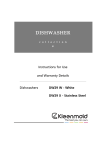
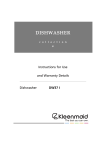
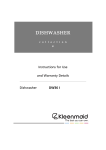
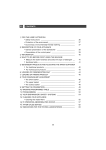
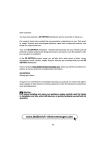
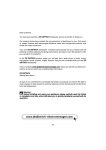
![DC120 Visual Presenter User Manual [Important]](http://vs1.manualzilla.com/store/data/005845319_1-bd6fa75798b576fdb4accb3798bb8932-150x150.png)


